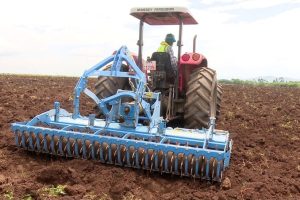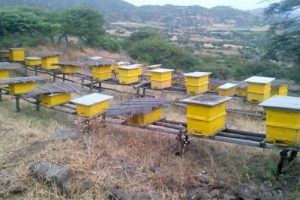
BY MENGESHA AMARE
The Ethiopian government has embarked on economic development strategy where agriculture is on the top of priority sectors. Ethiopia’s development plan has laid out enhancing agricultural production and productivity as one of the major strategic pillars.
Besides, the ten-year development plan aims at boosting agricultural export revenues and substituting imports by reducing production costs. The government seeks to leverage on developing huge unutilized arable land, modernizing production systems, and improving uptake of technology to attain the set target.
Taking the importance of focusing on agriculture and the way to make the sector much more productive into account, The Ethiopian Herald had a stay with Alemayehu Debasu, an agro economist graduated from AAU and working as an economic expert.
He said, “The ten-year perspective development plan envisages building a climate resilient green economy. In this regard, Ethiopia is looking to expand development efforts to fight land degradation and reduce pollution, diminish green house gas emissions, increase forest protection and development, increase production of electricity from renewable sources for domestic use and for export as well as focusing on modern and energy saving technologies.”
As to him, small plots of land found in a scattered manner need to be clustered, most small farms which are not suitable for mechanized agriculture system shall employ simple machines to be much more productive.
He said smallholding farmers usually produce cereals and some sorts of grains. Yes, he said, grains are the most important field crops and the chief element in the diet of most Ethiopians. The principal grains are teff, wheat, barley, corn, sorghum, and millet, and the first three are primarily cold weather crops cultivated at highlands. These agricultural produces have to be promoted and expanded in a bid to secure food security. He further elucidated that Ethiopia has sought to create dynamic economic centers that promote consumption and stimulate economic growth in various areas of the country.
Undoubtedly, he said Ethiopia’s economy is dependent on agriculture, which accounts for 40 % of the GDP, 80 % of exports, and an estimated 75 % of the country’s workforce. However, the sector has not been well exploited due to a number of factors, among others, low level of employing improved seeds, weak market linkages, lack of fertilizers and pesticides are highly attributable to the low level of agricultural production and productivity.
He said, “Agriculture-led economic growth that is linked to improved livelihoods and nutrition can become a long-lasting solution to Ethiopia’s chronic poverty and food insecurity in spite of the aforesaid challenges.”
“The government along with development partners is supporting the transformation of the agriculture sector by promoting higher productivity to generate greater incomes. Agricultural investments would also improve the competitiveness of value chain with commercial crops like sesame, coffee, maize, wheat, honey, livestock and etc. the government has also strengthened small-and medium-sized enterprises by providing access to credit and technical support. These activities bring jobs and income opportunities for rural households to lead brighter and more prosperous futures,” he said.
According to Alemayehu, the government of Ethiopia has focused on various core components— inclusive and sustainable agriculture-led economic growth, strengthening the resilience of people and institutions, improving nutrition, fostering a regulatory environment, among others, with a view to bolstering the economic growth in the country.
The government and concerned bodies are also working hard to address challenges that hinder small-scale mechanization, promotion of post-harvest handling, agronomy conservation, soil and water upkeep, crop improvement, proper livestock breeding and resilience.
He said, “It is time for stimulating market-led agricultural growth and rural transformation to aid vulnerable parts of the country. In addition, the government is endeavoring to improve the enabling environment to support private sector growth and investment in agriculture.”
Cross sector collaboration, which fosters trajectory from farm to fork, would play a critical role in building the resilience economic capacity to lift citizens out of the chronically food insecure and drought scenario, he said.
“Ethiopia has increased the amount of sown land to increase agricultural output. This would be achieved by extending irrigation to previously rain-fed cropland. True, expanding irrigation surges the output from that land and enables farmers to enjoy more than one crop to be grown each year,” he added.
According to Alemayehu, climate change combined with poor or traditional farming practices has reduced the health and productivity of Ethiopia’s agricultural land and water supply. Hence, improving soils, reducing erosion and ensuring widespread use of good nutrient management practices are of significantly useful in bolstering the production and productivity of the agriculture sector.
He further stated that mechanization rate has to be promptly augmented to fill the agricultural labor gap. The farming community in Ethiopia has employed various systems to produce more food for a growing population, via reducing water waste and pollution as well as responding to a changing climate.
In light of a range of challenges, more farmers are adopting innovative water management strategies, such as innovative irrigation systems. To this end, a number of agricultural institutes in the country conduct research and work with innovative agricultural partners to identify and scale strategies to improve water management and ensure a vibrant agricultural system.
Yes, he said inclusive innovation will be the key enabler for a just transition to net-zero, nature-positive food systems. Providing farmers with training and relevant agricultural education is also of indispensible value in inspiring them to test new technologies on their farms. This would help unlock smallholder farmers potential.
Farmers are working hard to enjoy transiting to more sustainable agricultural practices through minimizing the negative impacts compromising agricultural production and productivity. This move would also incentivize more sustainable production and practice by food producers.
He said, “However, agriculture, forestry and other types of land use are currently responsible for almost a quarter of global greenhouse gas emissions. Smallholder farmers, delivering one-third of food consumed globally, have a particularly important role to play in rousting local food systems, ending rural poverty and hunger as well as improving nutrition in developing countries, where food insecurity is most acute.”
He further stated that Ethiopia is characterized as a large country with numerous smallholder farmers. Given their importance, smallholders are the cornerstone of the people-centered approach of the country in solving problems of the agriculture sector targeting at eradicating extreme poverty via ensuring rapid social-economic growth in the country.
Investing in agriculture and small-scale producers has proved to be one of the most effective means for transforming rural livelihoods and creating demands for investment and consumption. True, investing in agriculture increases production stimulates private partnerships and contributes to higher incomes, ultimately providing strong support for stable growth and employment.
As to him, these innovative solutions and practices focusing on small-scale producers can be readily adapted technologically and economically to transform their agriculture sectors, rural economies and local food systems. Despite the opportunities offered by investing in agriculture and in smallholders to tackle on-going and emerging challenges like poverty and food insecurity, he said.
Unequivocally, he cited, as smallholder farmers are on the frontlines of confronting hardships including poverty, food insecurity and malnutrition, climate change, biodiversity loss, environmental degradation and social exclusion, they have to be well assisted for better agricultural productivity. The egalitarian allocation of agricultural land and small operational farm sizes in rural Ethiopia would help boost overall production and productivity, he said.
According to Alemayehu, agriculture is at the heart of Ethiopia’s food system with a view to ensuring food security. Since a range of farmlands have been degraded due to factors such as over-farming, over-cultivation, and over-grazing and weak forest conversion, the government as well as the general public are duty bound to collaboratively address as such a combined effort would help boost agricultural production and productivity.
In a nutshell, agricultural production and productivity can be augmented via principally properly addressing the hurdles of the sector such as poor agricultural land management practices, soil, wind and water erosion, and other related challenges. Some other challenges like surface runoff, loss of organic matter and fertility, loss of biodiversity and disruption in cycles of water, organic carbon and plant nutrients need to be well addressed with a view to promoting agricultural production and productivity.
Mechanized agriculture has to be intensified for better agricultural production
The Ethiopian Herald April 9/2023





